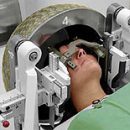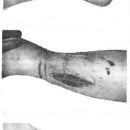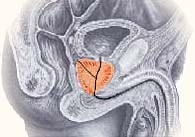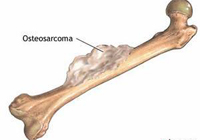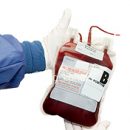According to statistics, every second man older than 50 years old appeals to the doctor about the prostate adenoma. It is believed that this disease is developing in 85% of men. These figures confirm the fact that prostate adenoma is the most common urological disease.
Content
What happens to the prostate gland in the development of adenoma?
Term «prostate adenoma» means that a small nodule (or nodules) is formed in the prostate, which grows and gradually squeezes the urethra. If the urethra did not pass through the prostate gland, the disease would not have been manifested at all. And so in patients with adenoma men are disturbed by urination, which is the main manifestation of the disease. Prostate adenoma has benign growth, that is, does not give metastases (does not apply to other organs). It is radically distinguished by adenoma from prostate cancer.
What are the causes of the disease?
The reasons for the development of prostate adenoma today are not fully clarified. It is believed that the adenoma of the prostate gland is one of the manifestations of male climax. Thus, the adenoma prostate risks every elderly man. The reliable connection was not detected between the appearance of the prostate adenoma and sexual activity, sexual orientation, tobacco and alcohol, transferred inflammatory and venereal diseases of the genital organs.
As the prostate adenoma is manifested?
As already mentioned, the disease is manifested mainly by urination disorders. It is believed that the disease begins at the moment when urination, especially with a bladder filled with a bladder, ceases to delight. Ideally, men must contact the doctor at this moment.
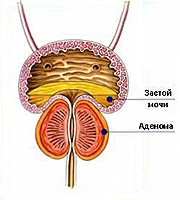
After some time, urine becomes a rapid, less free, less intense. The urine jet becomes weaker, the amount of urine allocated at a time decreases. The patient has a need to stand 1-2 times at night, which was never observed before. Another manifestation of the adenoma at this stage is the emergence of such strong urges to urine, which the patient cannot delay it even for a short time. Unfortunately, almost all men consider these phenomena as age or associate them with something and do not appeal to the doctor.
After a certain time, it becomes more difficult to urinate. String urine falls almost strangly, and not by ordinary curve. When urination has to strain the muscles of the abdomen. Sometimes patients with adenoma are so tired that during urination they have to take breaks for recreation.
Over time, in the absence of treatment, such patients may affect kidneys, renal failure, which is manifested by headache, thirst, dry mouth, weakness, irritability. The bladder is always filled with urine, when urinating urine is highlighted with a thin weaving or even dropwise. At the same time, the phenomena of urinary incontinence appear, that is, urine stands out on drops constantly and against the desire of the patient, first at night, and then and the clock.
What can be the complications of prostate adenoma?
In the absence of treatment, this process ends with the development of the acute urination delay - the urethra is completely finalized and no urine droplets. The patient at the same time is experiencing severe pain at the bottom of the abdomen. The bladder is filled and empty over the pubic.
It should be noted that the acute retention of urination may develop at any stage of the prostate gland adenoma, even on the earliest. It can trigger such factors such as long-term bladder flavored, supercooling, dietary error, alcohol intake.
Another complication of the prostate adenoma is hematuria - blood appearance in the urine. With increasing urine pressure in the bladder, its veins are damaged, they can cause bleeding.
Another complication of the prostate gland adenoma can be considered the formation of bladder stones. Stones are formed as a result of stagnation in it urine.
What does a urologist, when a patient's prostate adenoma comes to him?
After the patient's survey, the first thing that the urologist does, it pronounces the prostate gland through the rectum (finger rectal study). In addition, general blood and urine tests must be carried out, ultrasound, urofloumometry (method to estimate the speed of urine current), x-ray pelvis, with obscure cases - cystoscopy. With urination delay, the patient immediately put a catheter to provide urine outflow.
How the prostate adenoma is treated?
Treatment of prostate gland can be medicated, inertative and operational.
Drug treatment is effective only at the first stages of the disease, when the patient can void and urine derived from the bladder completely. Currently, there are drugs that allow not only to facilitate the course of the disease, but also reduce the volume of increased gland. However, these drugs should be applied strictly to the appointment of a doctor after passing a full survey.
There are prostate adenoma treatment methods - bladder catheterization, hyperthermia, thermal therapy and balon dilatation. The catheterization of the bladder is used in older men who cannot be operated on for health. The rest of the methods are still different, either yet poorly studied and therefore applied extremely rarely.
Operational methods of treatment of prostate adenoma are the most effective today. With a not very launched disease (the bladder empties completely, the kidney is not damaged) can be performed transurethral resection of the prostate (tour) - that is, the removal of the prostate adenoma through the urethra. This is a small-acting operation.
With a launched disease, when the adenoma reaches large sizes when the bladder is filled with urine and renal failure has already appeared, an ample or possession of adenomectomy is applied. These two operations are more traumatic than the tour, but they provide full cure from the disease.
If the patient's adenoma is still young and interested in preserving sexual activity, he is made by transurethral dissection of the prostate gland. This operation allows for a few more years to be a healthy person and lead sex life, but, after this time, you will have to re-operate and remove the hardware.
Prevention of prostate adenoma
Unfortunately, confirmed data on the prevention of prostate adenoma today does not exist. There is evidence that some preparations of phytotherapy, such as an African plum bark extract, reduce the risk of adenoma and increase potency, but this information is not confirmed by clinical studies.
In no case, it is impossible for the prevention of adenoma to take those drugs that are used for its treatment. Therefore, for the prevention of prostate adenoma, you can recommend all men older than 50 years old to take a habit once a year to go to a survey urologist.

